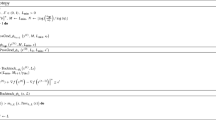Abstract
We consider the recent algorithms for computing fixed points or zeros of continuous functions fromR n to itself that are based on tracing piecewise-linear paths in triangulations. We investigate the possible savings that arise when these fixed-point algorithms with their usual triangulations are applied to computing zeros of functionsf with special structure:f is either piecewise-linear in certain variables, separable, or has Jacobian with small bandwidth. Each of these structures leads to a property we call modularity; the algorithmic path within a simplex can be continued into an adjacent simplex without a function evaluation or linear programming pivot. Modularity also arises without any special structure onf from the linearity of the function that is deformed tof.
In the case thatf is separable we show that the path generated by Kojima's algorithm with the homotopyH 2 coincides with the path generated by the standard restart algorithm of Merrill when the usual triangulations are employed. The extra function evaluations and linear programming steps required by the standard algorithm can be avoided by exploiting modularity.
Similar content being viewed by others
References
E. Allgower and K. Georg, “Simplicial and continuation methods for approximating fixed points”, Institute for Applied Mathematics, University of Bonn (August 1978),SIAM Review, to appear.
G. Birkhoff,Lattice theory (Am. Math. Soc., New York, 1940).
A.R. Curtis, M.J.D. Powell and J.K. Reid, “On the estimation of sparse Jacobian matrices”,Journal of the Institute of Mathematics and its Applications 13 (1974) 117–119.
B.C. Eaves, “A short course in solving equations with PL homotopies”, in: R.W. Cottle and C.E. Lemke, eds.,Nonlinear Programming, Proceedings of the Ninth SIAM-AMS Symposium in Applied Mathematics (SIAM, Philadelphia, PA, 1976) pp. 73–143.
B.C. Eaves and R. Saigal, “Homotopies for computation of fixed points on unbounded regions”,Mathematical Programming 3 (1972) 225–237.
B.C. Eaves and H.E. Scarf, “The solution of systems of piecewise linear equations”,Mathematics of Operations Research 1 (1976) 1–27.
M.R. Garey, R.L. Graham, D.S. Johnson and D.E. Knuth, “Complexity results for bandwidth minimization”,SIAM Journal on Applied Mathematics 34 (1978) 447–495.
M. Kojima, “Computational methods for solving the nonlinear complementarity problem”,Keio Engineering Reports 27 (1974) 1–41.
M. Kojima, “On the homotopic approach to systems of equations with separable mappings”,Mathematical Programming Study 7 (1978) 170–184.
M. Kojima, “A modification to Todd's triangulationJ 3”,Mathematical Programming 15 (1978) 223–227.
O.H. Merrill, “Applications and extensions of an algorithm that computes fixed points of certain upper semi-continuous point to set mappings”, Ph.D. Dissertation, Department of Industrial Engineering, University of Michigan (1972).
J.M. Ortega and W.C. Rheinboldt,Iterative Solutions of Nonlinear Equations of Several Variables (Academic Press, New York, 1970).
R. Saigal, “On the convergence rate of algorithms for solving equations that are based on methods of complementary pivoting”,Mathematics of Operations Research 2 (1977) 108–124.
R. Saigal, “On piecewise linear approximations to smooth mappings”,Mathematics of Operations Research 4 (1979) 153–161.
R. Saigal and M.J. Todd, “Efficient acceleration techniques for fixed-point algorithms”,SIAM Journal of Numerical Analysis 15 (1978) 997–1007.
H.E. Scarf with T. Hansen,Computation of economic equilibria (Yale University Press, New Haven, 1973).
M.J. Todd, “Orientation in complementary pivot algorithms”,Mathematics of Operations Research 1 (1976) 54–66.
M.J. Todd, “On triangulations for computing fixed points”,Mathematical Programming 10 (1976) 322–346.
M.J. Todd,The computation of fixed points and applications (Springer-Verlag, Berlin, Heidelberg, 1976).
M.J. Todd, “Improving the convergence of fixed-point algorithms”,Mathematical Programming Study 7 (1978) 151–169.
M.J. Todd, “A quadratically-convergent fixed-point algorithm for economic equilibria and linearly constrained optimization”,Mathematical Programming, to appear.
M.J. Todd, “Traversing large pieces of linearity in algorithms that solve equations by following piecewise-linear paths”, Technical Report 390, School of Operations Research and Industrial Engineering, Cornell University, Ithaca, NY (September 1978);Mathematics of Operations Research, to appear.
Author information
Authors and Affiliations
Additional information
This research was performed while the author was visiting the Mathematics Research Center, University of Wisconsin-Madison, and was sponsored by the United States Army under Contract No. DAAG-29-75-C-0024 and by the National Science Foundation under Grant No. ENG76-08749.
Rights and permissions
About this article
Cite this article
Todd, M.J. Exploiting structure in piecewise-linear homotopy algorithms for solving equations. Mathematical Programming 18, 233–247 (1980). https://doi.org/10.1007/BF01588321
Received:
Revised:
Issue Date:
DOI: https://doi.org/10.1007/BF01588321




